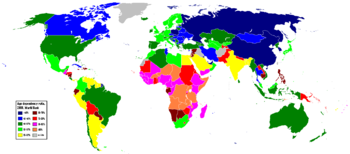- Dependency ratio
-
In economics and geography the dependency ratio is an age-population ratio of those typically not in the labor force (the dependent part) and those typically in the labor force (the productive part). It is used to measure the pressure on productive population
Contents
Formula
In published international statistics, the dependent part usually includes those under the age of 15 and over the age of 64. The productive part makes up the population in between, ages 15 – 64. It is normally expressed as a percentage:
As the ratio increases there may be an increased burden on the productive part of the population to maintain the upbringing and pensions of the economically dependent. This results in direct impacts on financial expenditures on things like social security, as well as many indirect consequences.
The (total) dependency ratio can be decomposed into the child dependency ratio and the aged dependency ratio[1]:
Inverse
The inverse of the dependency ratio, the inverse dependency ratio can be interpreted as how many independent workers have to provide for one dependent person (pension & expenditure on children)
Problems
A high dependency ratio can cause serious problems for a country. As the largest proportion of a government's expenditure is on health, social security & education which are most used by old and young population. Also the increasing expenditure on pension becomes a problem too.
Migrant Labor Dependency Ratio
Migrant Labor Dependency Ratio (MLDR) is used to describe the extent to which the domestic population is dependent upon migrant labor.[2][3]
See also
- Demographic economics
- Economic collapse
- Employment-to-population ratio
- Generational accounting
- Pensions crisis
- Sub-replacement fertility
- Societal collapse
Case studies:
References
- ^ Association of Public Health Epidemiologists in Ontario
- ^ http://rspas.anu.edu.au/~athu/Journal%20Papers/International%20labou%2006.pdf
- ^ http://books.google.com.au/books?id=UllpLB1hwdIC&pg=PA440&lpg=PA440&dq=migrant+labor+dependency+ratio&source=bl&ots=lEH6LruK1C&sig=toLCqVbMsW1J1SrJNKsCPb1VKYY&hl=en&ei=r6lZTrGyEMHTmAXBiIm-DA&sa=X&oi=book_result&ct=result&resnum=5&sqi=2&ved=0CDYQ6AEwBA#v=onepage&q&f=false World migration 2008: managing labour mobility in the evolving global economy By International Organization for Migration
External links

This economic problem related article is a stub. You can help Wikipedia by expanding it.




